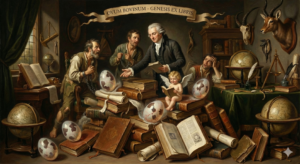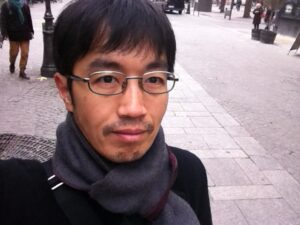Special contribution | Reuniting with Margaret Leng Tan | Eiko Sudoh
 Reuniting with Margaret Leng Tan
Reuniting with Margaret Leng Tan
text & photos by Eiko Sudoh
Photo provided by Margaret Leng Tan
Margaret Leng Tan is one of the best avant-garde pianists in the world. Born in Singapore, she got a scholarship at the age of 16 and entered the Juilliard School in New York. Afterwards, She was a first woman to get a doctorate at The Juilliard School. In 1981 she met John Cage, one of the greatest composers of the 20th century. Since then she has performed his work in various countries around the world. She has played an important role as a performer in the development of American experimental music. Awakened to the appeal of the Toy Piano from her collaboration with Cage, she released the CD “The Art of the Toy Piano” in 1997. She is called “Queen of the Toy Piano” and keeps doing unique activities as the world’s first toy piano virtuoso.
 It was in the spring of 2007 that I met Margaret for the first time. She held a commemorative live event for opening of the documentary film “The Art of the Toy Piano / The World of Margaret Leng Tan” (directed by Evans Chan) at UPLINK CINEMA SHIBUYA. Since I was empathized with her way of life as someone who jumped into the world of contemporary music from classical music as an Asian pianist, I was deeply moved when I met her. After that, in the autumn of 2008, I went to New York as a scholarship student with the Asian Cultural Council (ACC) and took her lessons, mainly studying cage’s works. I learned Cage’s musical philosophy in her lovely Brooklyn home, which provide a wonderful environment with a splendid Steinway and numerous Toy pianos. These experiences have became my treasures. It took ten years to see her again. One day last summer, I got a nice mail, “Coming to LA!” from Margaret. She was supposed have a concert in Los Angeles, where I moved to from Japan two years ago, to have a concert. I decided to take my children, whom she always cared about, to her performance.
It was in the spring of 2007 that I met Margaret for the first time. She held a commemorative live event for opening of the documentary film “The Art of the Toy Piano / The World of Margaret Leng Tan” (directed by Evans Chan) at UPLINK CINEMA SHIBUYA. Since I was empathized with her way of life as someone who jumped into the world of contemporary music from classical music as an Asian pianist, I was deeply moved when I met her. After that, in the autumn of 2008, I went to New York as a scholarship student with the Asian Cultural Council (ACC) and took her lessons, mainly studying cage’s works. I learned Cage’s musical philosophy in her lovely Brooklyn home, which provide a wonderful environment with a splendid Steinway and numerous Toy pianos. These experiences have became my treasures. It took ten years to see her again. One day last summer, I got a nice mail, “Coming to LA!” from Margaret. She was supposed have a concert in Los Angeles, where I moved to from Japan two years ago, to have a concert. I decided to take my children, whom she always cared about, to her performance.
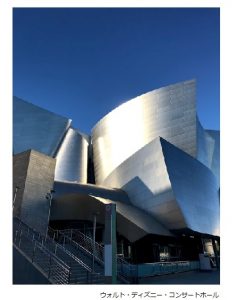 On the first day of November, when the signs of autumn came to California, my dream to see her again came. In Walt Disney Concert Hall, which is so attractive for Los Angeles’ tourists with its innovative architectural design, there is an interdisciplinary contemporary art center, Red Cat, operated by the California Institute of Arts (CAL Arts). This center, which plays an active role in ambitious events in all fields such as visual, performing and media art, invited Margaret this time. She has had a lot of concerts around the world, but this was her first performance on the West Coast. Although the performance began late night at 8:30 pm on the weekdays, a lot of people gathered for the West Coast debut performance of the East Coast global avant-garde pianist.
On the first day of November, when the signs of autumn came to California, my dream to see her again came. In Walt Disney Concert Hall, which is so attractive for Los Angeles’ tourists with its innovative architectural design, there is an interdisciplinary contemporary art center, Red Cat, operated by the California Institute of Arts (CAL Arts). This center, which plays an active role in ambitious events in all fields such as visual, performing and media art, invited Margaret this time. She has had a lot of concerts around the world, but this was her first performance on the West Coast. Although the performance began late night at 8:30 pm on the weekdays, a lot of people gathered for the West Coast debut performance of the East Coast global avant-garde pianist.
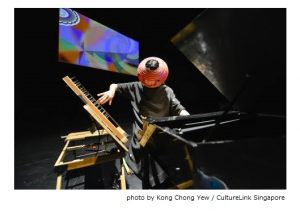 Margaret performed “Curious” in the first half of the program.It was a multimedia work with video,toy pianos and toy instruments composed by a young toy pianist in New York, Phyllis Chen, and played for the first time by Margaret in Singapore’s international festival in 2015. This work, consisting of six scenes, began with a scene where Margaret, wearing a mask, moved the spring dolls one after another in front of a screen that showed a strange world made of Lego pieces. Through the work, using toy percussion instruments, toy pianos, mini string instruments, music boxes, toy organs, bird whistles, etc., and transforming her mask into a magic lantern and clown nose, she took the audience to a strange and fascinating “Cabinet of Curiosities”. I was so impressed again by Margaret’s ability to create deep beauty from inexpensive instruments, especially in the fourth scene where I almost cried at the innocent sound of Toy Piano.There were other children besides my children in the concert hall. They also became glued to every move of Margaret on stage, while occasionally grinning at her humorous charm.
Margaret performed “Curious” in the first half of the program.It was a multimedia work with video,toy pianos and toy instruments composed by a young toy pianist in New York, Phyllis Chen, and played for the first time by Margaret in Singapore’s international festival in 2015. This work, consisting of six scenes, began with a scene where Margaret, wearing a mask, moved the spring dolls one after another in front of a screen that showed a strange world made of Lego pieces. Through the work, using toy percussion instruments, toy pianos, mini string instruments, music boxes, toy organs, bird whistles, etc., and transforming her mask into a magic lantern and clown nose, she took the audience to a strange and fascinating “Cabinet of Curiosities”. I was so impressed again by Margaret’s ability to create deep beauty from inexpensive instruments, especially in the fourth scene where I almost cried at the innocent sound of Toy Piano.There were other children besides my children in the concert hall. They also became glued to every move of Margaret on stage, while occasionally grinning at her humorous charm.
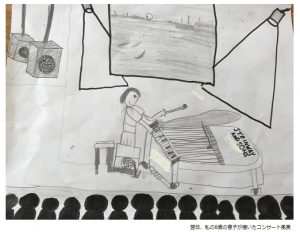 In the second half of the program, Margaret played “Metamorphoses (book I)” composed by George Crumb for Margaret over two years between 2015 and 2017. This was the piano song collection since the important American composer Crumb wrote his major piano collection “Makrokosmos” series. In “Metamorphoses (book I), each of the ten songs he composed were inspired by ten paintings by Paul Clay, Van Gogh, Chagall, Whistler, Jasper Jones, Gauguin, Dali, Kandinsky etc, so Margaret performed each song with each painting on the screen behind her. Her avant-garde abilities were fully demonstrated in this song collection. She played not only the keyboard of the piano, but also the string inside with fingers, mallet and wire brushes. Sometimes she got under the piano to play the special effects of the pedal, while also emitting various voices, and played the grand piano with her left hand while playing the toy piano with her right hand. It was hard to believe that those ten acoustic worlds were produced by one pianist. I especially enjoyed the eighth piece “The Persistence of Memory” painted by Dali, where clocks were softly melting in the desert, listening to the sound of the wind and the silence created by her. Children also seemed to enjoy a special experience with strong impressions using all of their audiovisual awareness.
In the second half of the program, Margaret played “Metamorphoses (book I)” composed by George Crumb for Margaret over two years between 2015 and 2017. This was the piano song collection since the important American composer Crumb wrote his major piano collection “Makrokosmos” series. In “Metamorphoses (book I), each of the ten songs he composed were inspired by ten paintings by Paul Clay, Van Gogh, Chagall, Whistler, Jasper Jones, Gauguin, Dali, Kandinsky etc, so Margaret performed each song with each painting on the screen behind her. Her avant-garde abilities were fully demonstrated in this song collection. She played not only the keyboard of the piano, but also the string inside with fingers, mallet and wire brushes. Sometimes she got under the piano to play the special effects of the pedal, while also emitting various voices, and played the grand piano with her left hand while playing the toy piano with her right hand. It was hard to believe that those ten acoustic worlds were produced by one pianist. I especially enjoyed the eighth piece “The Persistence of Memory” painted by Dali, where clocks were softly melting in the desert, listening to the sound of the wind and the silence created by her. Children also seemed to enjoy a special experience with strong impressions using all of their audiovisual awareness.
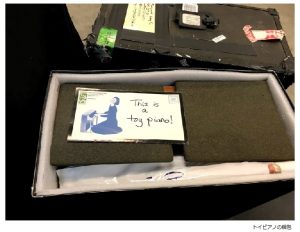 The next day, I visited Red Cat again to help Margaret to carry out her instruments. She looked so tired.Together with her, I packed a large number of toys into her suitcases. While we were packing, she told me some stories such as how hard it was to arrange and use all instruments without any mistake in the production, and how she got shocked when the suitcase was lost during transport. “But no matter how performers have difficulty, that has nothing to do with the audience…sound that comes out in the production is all that matters” she said clearly. After we finished carrying out the luggage, we went to a nearby cafe to have lunch together. There, beginning with various stories about the previous ten years, our topic led to children’s education and the fears of contemporary society. “Even in New York where I live, everybody watches smartphones anytime, anywhere. Why is the webworld so important … Why don’t they feel alive in the world they live in more … ” she said. From such a story, I remembered Cage’s theory “Life = Art = Theater” that I learned from Margaret 10 years ago. My best friend, who stayed in New York also as an ACC scholarship student at the same time with me, recently reminded me of it by Email. Yes, what I feel this moment by myself …, that is to be alive and to do music. Reuniting with Margaret, I felt like I could find the meaning of living and performing music for the first time in a long while, and I looked up at the blue sky of California with a fresh hope.
The next day, I visited Red Cat again to help Margaret to carry out her instruments. She looked so tired.Together with her, I packed a large number of toys into her suitcases. While we were packing, she told me some stories such as how hard it was to arrange and use all instruments without any mistake in the production, and how she got shocked when the suitcase was lost during transport. “But no matter how performers have difficulty, that has nothing to do with the audience…sound that comes out in the production is all that matters” she said clearly. After we finished carrying out the luggage, we went to a nearby cafe to have lunch together. There, beginning with various stories about the previous ten years, our topic led to children’s education and the fears of contemporary society. “Even in New York where I live, everybody watches smartphones anytime, anywhere. Why is the webworld so important … Why don’t they feel alive in the world they live in more … ” she said. From such a story, I remembered Cage’s theory “Life = Art = Theater” that I learned from Margaret 10 years ago. My best friend, who stayed in New York also as an ACC scholarship student at the same time with me, recently reminded me of it by Email. Yes, what I feel this moment by myself …, that is to be alive and to do music. Reuniting with Margaret, I felt like I could find the meaning of living and performing music for the first time in a long while, and I looked up at the blue sky of California with a fresh hope.
(Dec. 15, 2018)
This Article in Japanese: http://mercuredesarts.com/2018/12/14/column-special-margaret-leng-tan-sudoh/
——————-
Eiko Sudoh
While studying at Tokyo National University of Fine Arts and Music, school of Musicology, Eiko worked as a pianist with many composers who were the same age as her, and also learned broadly about aesthetics, ethnology, and management of music. In 2004, she won the ninth JILA Music Competition Contemporary Music Special Award, the first prize for the sixth contemporary music performance contest “Competition VI”, and won the 14th Asahi Contemporary Music Award. After that, Eiko studied contemporary music in Boston under the grant from Nomura International Cultural Foundation, and in New York as a scholarship student of Asian Cultural Council in 2008. The following year, she played at Carnegie Hall as a guest performer of the YouTube Symphony Orchestra. Eiko has written for the series “Piano Song MADE IN JAPAN” with sound source on PTNA website since 2006. Also she released her first CD album “Let’s play the toy piano ♪”(Columbia) in 2012. After working as lectures at Senzoku Gakuen High School Music Department, Wayo Women’s University, Tokyo City University, she has been living in Los Angeles from 2017.
